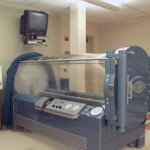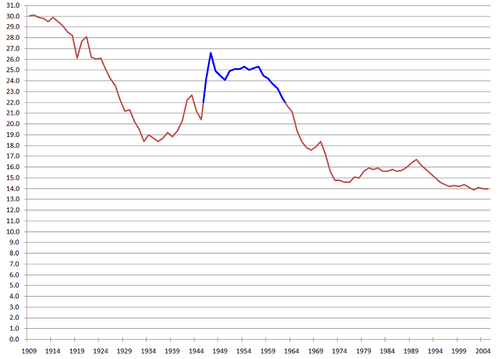Posts Tagged ‘hyperactive’
 Hyperbaric Oxygen Therapy (HBOT) provides relief for a host of neurological and learning problems
Hyperbaric Oxygen Therapy (HBOT) provides relief for a host of neurological and learning problems
Hyperbaric Oxygen Therapy (HBOT), or 100% oxygen supplied under varying pressures in a tightly-sealed compression chamber, has proven to be an astounding help for a host of brain problems. Side effects are minimal to non-existent. You would think the mainstream medical community would quickly make it a solid adjunct to whatever else they are doing for the healing of toxin-damaged or older brains. In reality, other countries are far ahead of North America in this regard.
Horizontal lie-down HBOT one-person compression chamber; photo from www.adventisthealthnw.com/HM-HBOT.asp
Sit-up HBOT one-person compression chambers at Canadian Hyperbarics, at the General Hospital, in Edmonton, Alberta, CANADA; Link to Canadian Hyperbarics website: http://www.canadianhyperbarics.com
Photo by Director Gordon Ward, Director, Canadian Hyperbarics, http://www.canadianhyperbarics.com
………………………………………………………………………………………………
Despite the wide array of problems for which HBOT is effective, our Canadian and US society has managed to keep this valuable and life-saving therapy in an ongoing controversial turmoil for decades. This may be because it appears to be expensive, and governments are fearful of incurring very large costs if large numbers of people realized how useful and effective it is.
In reality, the costs of HBOT pale in comparison with the huge costs associated with the ongoing and very expensive conventional treatments for heart disease, stroke, neurological problems, diabetes, MS, etc.
Part of the problem may simply be that the Undersea & Hyperbaric Medical Society (who devised the hodgepodge and limited list of conditions which government and insurance-approved facilities generally use to prevent access to this priceless therapy) is an ultra-conservative organization not prone to real leadership in HBOT.
Thank heaven for the private freestanding clinics that know that hyperbarics will heal a host of brain problems and other problems, and that provide genuine and much-needed leadership in HBOT.
One such is Canadian Hyperbarics at the General Hospital in Edmonton, Alberta, CANADA. They will help anyone who is up against the barriers of the highly-limited treatment provided by government or insurance-funded HBOT.
The Director of Canadian Hyperbarics is Gordon Ward, a personable and internationally-known expert in the HBOT field. Humorous and self-effacing, Mr. Ward has unfortunately often been obliged by forced circumstances to reluctantly demonstrate greater knowledge and expertise than many government or insurance-funded facilities staffed with hyperbaric physicians. More about Canadian Hyperbarics in future posts.
For more information about Canadian Hyperbarics and HBOT, please copy and paste the following URL into your computer’s browser line, the line you use when you want to get to a specific website on the internet:
http://canadianhyperbarics.com/index.html
Mitigation of neurological problems, including memory problems
There are more than 75 million “baby boomers” in the United States, and millions more in Canada, who could use HBOT to ward off memory problems as they age, and this would require a huge outlay of public funds if HBOT were approved for this purpose:
WIKIPEDIA – The Free Encyclopedia, graphed the “baby boomer” cohort:
United States birth rate (births per 1000 population). The blue segment is the postwar baby boom.
…………………………………………………………………………………………………..
I am familiar with the mitigating effects of HBOT on neurodegenerative problems, Cerebral Palsy, LD (Learning Disabilities), ADD (Attention Deficit Disorder), ADHD (Attention Deficit Hyperactivity Disorder), ODD (Oppositional Defiant Disorder), Autism, and a host of other brain problems and potential brain problems.
Governments typically only recognize the effectiveness of HBOT for a short list of ailments, such as carbon monoxide poisoning, gas gangrene, necrotizing tissue (“flesh-eating disease”), near drowning, decompression sickness (“the bends” to divers), crush injury, burns, exceptional blood loss (severe anemia), advanced wound care including diabetic wound care, and so on. It is a very narrow and short list of 13 conditions created by UHMS (Undersea & Hyperbaric Medical Society) and adopted by governments and insurance companies for treatments for reimbursement purposes. This protects governments and insurance companies from the large costs that would be incurred if all of the ailments that can be treated effectively were appropriately approved for coverage.
It must be said here that many countries in other parts of the world are far ahead of the United States and Canada when it comes to proper utilization of HBOT for a wide variety of conditions. For one thing, they have far more HBOT compression chambers than is the case in the US and Canada. Some countries even have mobile HBOT chambers for emergency use.
The prevailing philosophy in many countries worldwide is to increase immediate access to a HBOT chamber in the case of heart attack and brain attack (stroke), as it has been proven beyond all reasonable doubt that immediate HBOT treatment makes a huge difference to outcomes for the victims of these common problems. HBOT is, literally, life-saving. More, it vastly increases the future quality of life of those it saves. And those it prevents from having serious brain problems.
To your brain health!
Doc Meek, May 8, 2010, at Sherwood Park, Alberta, CANADA
P.S. If you wish to pursue this topic of HBOT further, Kathy Summers has written a top-notch article.
Thank you, Kathy! LINK: http://www.healthwriting.com/health/hbot/
 Want your brain sharp? Give it a rest
Want your brain sharp? Give it a rest
Today is Sunday and it made me think about reminding all of us to give our brains a period of rest, a sabbath (lower case).
Many religions observe a weekly day of rest, a Sabbath (upper case), a day to turn their work-a-day thinking/feelings in another direction. To look upward and notice loftier things. Or softer and gentler things. Things of the heart, things of the spirit. Many Muslims observe Friday as their Sabbath; many Jews observe Saturday as their Sabbath; and many Christians observe Sunday as their Sabbath.
Many people relate to nature as their sabbath.Walking in nature can sometimes provide an uplift found nowhere else.
Universities may provide a sabbatical year for professors, a year in which they can relax and refresh and renew their research interests.
“Believers” and “Non-believers” Alike
Whether we are “believers” or “non-believers,” our brains still need a “time out,” a sabbath. It improves our ability to learn, to remember, to be sharp. Sharp and awake. Mentally, physically, socially, emotionally, spiritually.
As Stephen R. Covey (1989, 2004) reminded us in The 7 Habits of Highly Effective People: Powerful Lessons in Personal Change, if we just keep on sawing with the same old saw, over and over again, it will get dull.
He told us that it is essential to stop, to “sharpen the saw.” If we just keep sawing on, hoping to finish the pile of lumber today, we just become less and less efficient. Finally, we are still working very hard indeed and not much lumber is getting cut. The saw is simply too dull to do its work properly.
Stop. “Sharpen the saw.”
How Often Do Our Brains Need R and R?
How often should we stop to sharpen the saw, to give our brain a time of rest and renewal?
Every 7 years?
Annually?
Monthly?
Weekly?
Daily?
Hourly?
Every 10-20 minutes?
All of the above? Yes, and I’ll tell you why.
Our brain, somewhat analogous to our muscles, needs work to develop and be strong, and needs rest to recuperate and renew. Such renewal periods, whether taken after 20 minutes of homework, or a hard week’s work at the office or factory, improve memory, focus, attention, interest, and all manner of cognitive abilities that delight and bless us.
Now . . . today . . . and on to infinity.
Doc Meek, May 2, 2010
Sherwood Park, Alberta, CANADA
 Son labeled ADD (Attention Deficit Disorder)
Son labeled ADD (Attention Deficit Disorder)
I mentioned to the Mom whose son had been labeled ADD (Attention Deficit Disorder) that I was not fond of labels. I said that while a “private label” may be necessary for funding, insurance, or medical purposes, I hoped that in everyday life, neither she nor her son would take the label too seriously in terms of finding solutions for school problems.
I have found that when working with a child who has been labeled ADD, say in grade 4, that I would generally ignore the label and inquire: “Harold, the teacher tells me that you have the ‘squirmies’ in her class, that you are a bit restless, that you don’t find it easy to stay at your desk. Is that right?”
I have found that it is much easier to help the child find ways to overcome the “squirmies” than it is to overcome a label, which is, in the final analysis, really a description of the child’s behavior, not an eternal pronouncement carved in stone.
No one really knows what’s going on inside the child’s head, exactly. I would much rather work with a friendly mystery, than a dismal certitude, wouldn’t you? Besides success is greatly enhanced when you work with concrete behavior, not deterministic labels.
The same problem occurs with adults. Let’s say somebody has been labeled “alcoholic.” It is a lot easier for them to change their behavior when I work with them in overcoming their “drinking problems,” which is a set of concrete behaviors, with which we can work, piece by piece, as opposed to trying to refute a label that some think is stamped in their psyche “forever.” – Doc Meek, South Jordan, Utah


